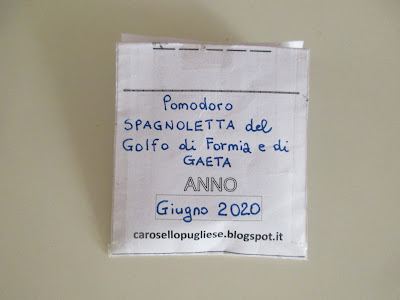È già tempo di pensare ai semi per l'anno prossimo. I primi frutti di ogni varietà di pianta coltivata sono di solito destinati per fare i semi per la stagione successiva. Quest'anno il pomodoro Spagnoletta di Gaeta è stato il più veloce:
 |
| (1) Frutto ben maturo, ma non sfatto |
 |
| (2) Taglio longitudinale |
 |
| (3) Semi messi in una coppetta ad aspettare la benefica muffa |
 |
| (4) La tanto attesa muffa che sanifica i semi |
 |
| (5) Nel colino in attesa del risciacquo |
 |
| (6) Dopo il risciacquo |
 |
| (7) Messi ad asciugare |
 |
| (8) Pronti per l'anno prossimo |
Se qualche amico ortolano vuole aggiungere qualcosa a questo procedimento, è il benvenuto.
----------------------------------------------------------------------------------------------------------
THE FIRST SEEDS FOR NEXT YEAR - report of June 24th
It's already time to take care of seeds for next year. The first fruits of every variety of a cultivated plant are usually appointed for saving seeds for the following season. This year the Spagnoletta di Gaeta tomato has been the fastest.
Below listed the procedure I use to save tomato seeds:
1) I harvest tomatoes well ripe, but not overripe.
2) I cut tomatoes lenghtwise.
3) I put all seeds in a cup expecting the beneficial mould: it sanitizes the seeds.
4) Once the mould shows up...
5) ...I put the seeds in a strainer.
6) I let the water run in the strainer and rinse the seeds.
7) I put the seeds in a dish and let them dry.
8) Final step: I put them in a paper envelope.
If some gardener friends want to add something to this procedure, they are welcome.
Ciao Giuseppe
RispondiEliminaSecondo me non c'è niente da aggiungere all'ottima spiegazione.
Perfetto come sempre. Quanti ricordi, le spagnolette! 🤣
RispondiEliminaCiao Claudia,
EliminaFu una roba da manicomio!
-Giuseppe-
Interesting. I put my tomato seeds in glass jars and the pulp is mostly disintegrated by the time I rinse out the seeds.
RispondiElimina